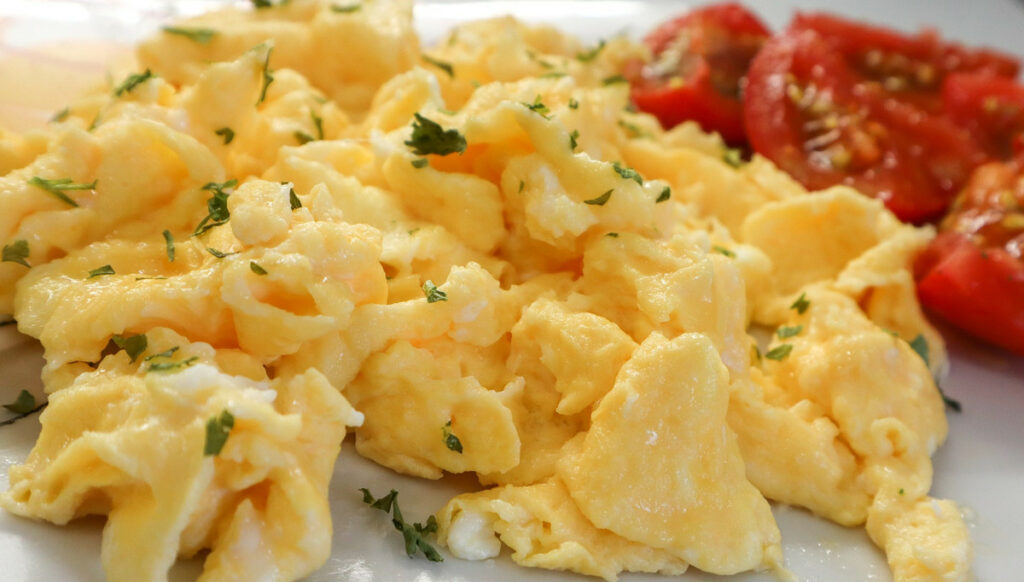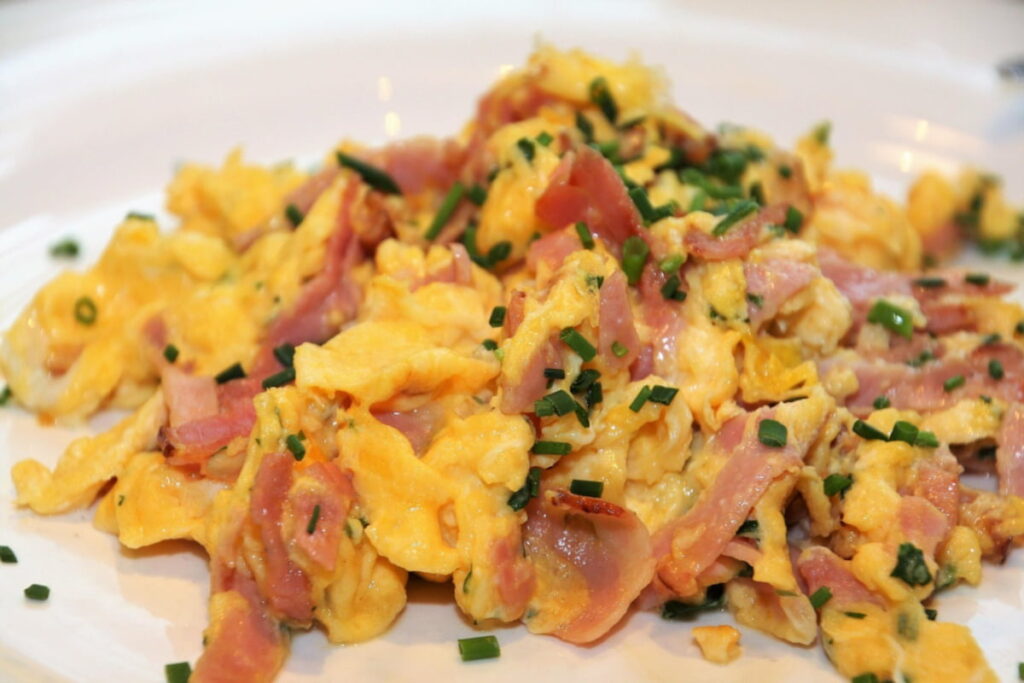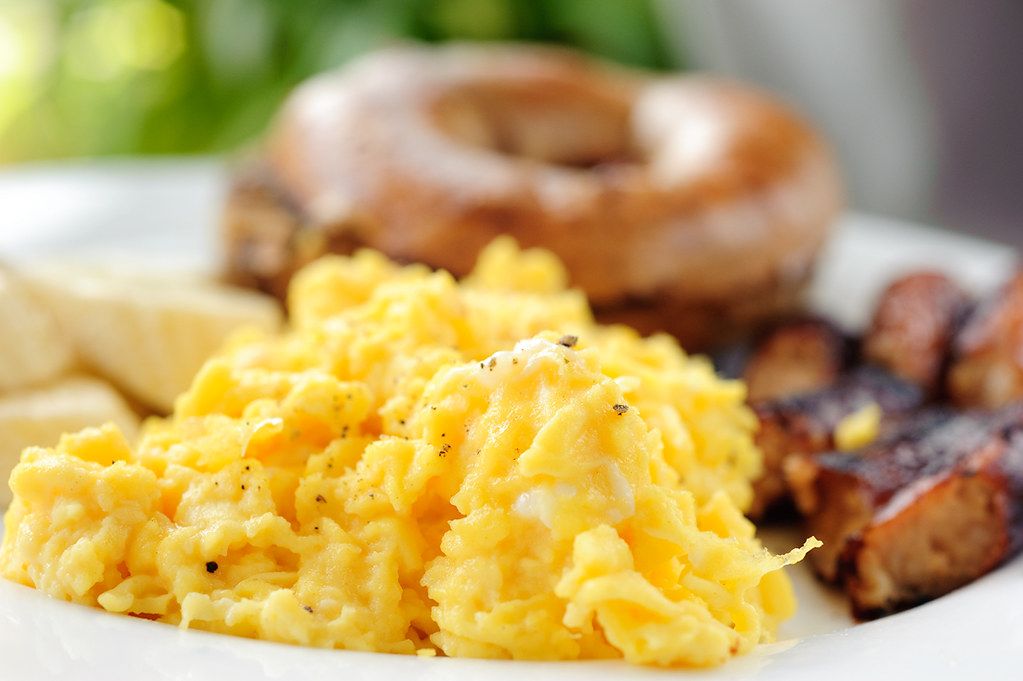
If you’re busy, half-asleep in the mornings, and still trying to eat something real, this little freezer trick changed everything for me. You can actually freeze scrambled eggs, and if you do it right, they stay soft, tasty, and ready in seconds.
Whether you’re meal-prepping, juggling kids, or just want one less thing to think about before coffee, this simple hack brings calm to chaotic mornings.
In this guide, I’ll show you exactly how to do it, the right way, plus what to expect, how to reheat them perfectly, and why this tiny habit is worth keeping.
Do Frozen Scrambled Eggs Still Taste Good?

This is the first question everyone asks.
And the truth is, frozen scrambled eggs can taste great… if you make them the right way (before freezing0
The problem isn’t freezing, it’s how the eggs are cooked before they ever hit the freezer.
Scrambled eggs are delicate. When they’re cooked too hot or too long, the proteins tighten and push out moisture. Freeze that dryness, and you lock in a rubbery texture.
However, when done properly, they taste surprisingly close to fresh:
- Flavor: Mild, buttery, and comforting. Not exactly “from the pan,” but far from bland.
- Texture: Soft and tender, not spongy or watery.
- Best for: Burritos, wraps, or breakfast bowls, real food for real mornings.
The secret is stopping early, when the eggs are just in that glossy stage and slightly underdone. That trapped moisture protects them through freezing and reheating.
Think of it like cookies, slightly underbaked now means perfect later.
How to Freeze Scrambled Eggs (the Right Way)

Once you know what makes them work, the process is simple. The goal is to lock in moisture, minimize air exposure, and prevent overcooking, the trifecta of tender eggs after freezing.
1. Cook Them Gently
- Whisk your eggs with a splash of milk or water to help retain moisture.
- Use low to medium-low heat and stir slowly.
- Remove from the pan when they’re just set and still glossy, they’ll finish cooking when reheated.
- Avoid browning or drying them out; that’s where most people go wrong.
Why this works: Gentle heat keeps the proteins loose and moist, so they survive the freeze and reheat without turning rubbery.
2. Cool Completely
- Spread the cooked eggs on a plate or baking sheet to cool quickly.
- Cooling prevents steam from creating ice crystals that cause freezer burn.
- Never freeze eggs while warm, trapped moisture will ruin the texture later.
3. Portion and Store
- Divide cooled eggs into single portions.
- Store in airtight freezer bags, silicone cups, or glass containers.
- If using bags, flatten them before sealing to save space and help them thaw evenly.
- Label with the date and contents, they’ll stay good for about three months.
4. Freeze Properly
- Place portions flat in the freezer so they harden evenly.
- Once frozen, stack or organize them by meal type (e.g., “plain,” “with cheese,” “veggie mix”).
- Avoid constant thawing and refreezing, which ruins texture.
Once your scrambled eggs are safely frozen, the real test comes when you reheat them.
This is where most people either get perfect, fluffy results, or ruin all that prep in sixty seconds.
Some people freeze dry scrambled eggs. If that is something you are interested in, check out the video below.
Related: Can You Freeze an Omelet?
How to Reheat Frozen Scrambled Eggs (Without Ruining Them)

Once your scrambled eggs are frozen, the next step is bringing them back to life, warm, soft, and satisfying. This part matters just as much as how you froze them.
The golden rule: low and slow.
High heat turns delicate proteins rubbery, while gentle heat lets them warm evenly and stay tender.
Quick Overview:
- Reheat straight from frozen, no need to thaw.
- Microwave: Use medium power (50%) for 45–60 seconds, stirring halfway. Cover with a damp paper towel to trap steam.
- Skillet: Warm over low heat for 2–3 minutes with a touch of butter or oil, stirring gently until heated through.
If you’re reheating breakfast burritos, egg sandwiches, or meal-prep bowls, the same principle applies, gentle, even heat is key.
For a full walk-through with timing, tips, and microwave vs. stovetop comparisons, see my complete guides:
- How to Reheat Scrambled Eggs Without Ruining Them
- How to Reheat Eggs (Any Style) Without Drying Them Out
Add-Ons and Freezer Hacks

Once I realized how well scrambled eggs actually hold up in the freezer, I started getting creative.
They went from being a backup breakfast to one of my favorite meal-prep building blocks. Think of them as a blank canvas, soft, protein-packed, and ready for anything.
Make-Ahead Breakfast Combos
These are the go-tos that turned my freezer into a mini breakfast station:
- Breakfast Wraps: Spoon scrambled eggs into tortillas with cheese, spinach, and sausage. Roll them up, wrap in foil, and freeze. In the morning, just pop one in the microwave, instant grab-and-go breakfast that tastes freshly made.
- Egg Bowls: Layer frozen eggs with roasted potatoes or rice, veggies, and a drizzle of hot sauce. Microwave, stir, and you’ve got a quick, filling meal that feels intentional, not improvised.
- English Muffin Sandwiches: Add eggs, a slice of cheese, and ham or bacon to an English muffin. Wrap and freeze, they reheat straight from frozen and taste just as satisfying as a drive-thru sandwich (without leaving the house).
Flavor Add-Ins That Freeze Well
After a few rounds of experimenting, I learned what holds up, and what doesn’t.
What works:
- Cheese: Cheddar and Monterey Jack freeze surprisingly well and melt smoothly back into the eggs when reheated. Feta can work too, it gets a little crumbly after thawing, but if you mix it in before freezing, it adds nice salty bursts of flavor.
- Veggies: Cooked peppers, onions, spinach, or kale. A quick sauté before freezing keeps them flavorful and prevents sogginess.
- Herbs: You can add your favorite egg seasonings and even cheese when cooking them if you want. The preparation process won’t change when the scrambled eggs are frozen; it’s only to give them great flavor.
- Proteins: Crumbled sausage, chopped bacon, or diced ham. They make the eggs heartier and add that savory kick.
What doesn’t:
Skip watery vegetables like tomatoes, zucchini, or mushrooms. They release moisture when thawed and can make the eggs mushy.
Less Chaos, More Breakfast
Freezing scrambled eggs won’t change your life, but it might change your mornings. It’s one of those small habits that makes everything run smoother once you try it.
This isn’t about perfect cooking, it’s about knowing how to properly freeze food so it works for real life. Cook once, freeze smart, and you’ll have warm, ready breakfasts waiting all week.
Tried your own version? Have a trick for keeping them soft or flavorful? Drop it in the comments, your tip might make someone else’s mornings a little easier, too.
